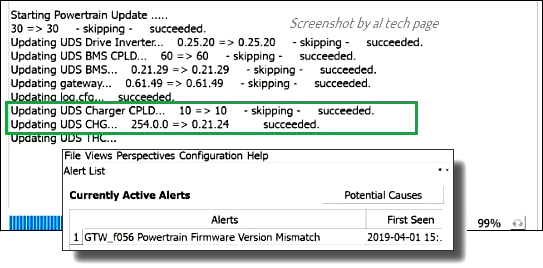I am posting this story as a link to a PDF for my simplicity.
https://1drv.ms/b/s!AtSKKmN-5msBg_oYXNH9E1vYZ_8bDA
If you have trouble accessing it then contact me and I can email it to you. Here is the summary from the first paragraph and a teaser picture of the repair process (if I can get the image tag to work).
The bottom line is this: If your RAV4 EV tries to charge a few times but won’t then it is probably a problem with the on-board charger. 90% of the time, just replacing the fuses fixes this problem like this (https://www.myrav4ev.com/forum/viewtopic.php?p=29795#p29795) and this (https://www.myrav4ev.com/forum/viewtopic.php?t=2463&sid=29a9bda734c0e413058ea12395f8a713). Unfortunately, I was in that 10% where a “simple” fuse replacement did not fix my on-board charger. Not only did I need to buy a used Gen 1 Tesla Model S onboard replacement charger, but it took nearly six months to get my car back up and running because, 1) I knew almost nothing about electric cars, 2) I am fortunate enough to have two cars so repairing my RAV4 EV, while important to me, was not urgent, 3) several other issues surfaced along the way, 4) I needed help from some amazing people on this forum, especially alflash and Davio, 4) it took swapping some of the guts between my original charger and the replacement charger. For those interested, here is my story and the details of how it unfolded.

https://1drv.ms/b/s!AtSKKmN-5msBg_oYXNH9E1vYZ_8bDA
If you have trouble accessing it then contact me and I can email it to you. Here is the summary from the first paragraph and a teaser picture of the repair process (if I can get the image tag to work).
The bottom line is this: If your RAV4 EV tries to charge a few times but won’t then it is probably a problem with the on-board charger. 90% of the time, just replacing the fuses fixes this problem like this (https://www.myrav4ev.com/forum/viewtopic.php?p=29795#p29795) and this (https://www.myrav4ev.com/forum/viewtopic.php?t=2463&sid=29a9bda734c0e413058ea12395f8a713). Unfortunately, I was in that 10% where a “simple” fuse replacement did not fix my on-board charger. Not only did I need to buy a used Gen 1 Tesla Model S onboard replacement charger, but it took nearly six months to get my car back up and running because, 1) I knew almost nothing about electric cars, 2) I am fortunate enough to have two cars so repairing my RAV4 EV, while important to me, was not urgent, 3) several other issues surfaced along the way, 4) I needed help from some amazing people on this forum, especially alflash and Davio, 4) it took swapping some of the guts between my original charger and the replacement charger. For those interested, here is my story and the details of how it unfolded.














